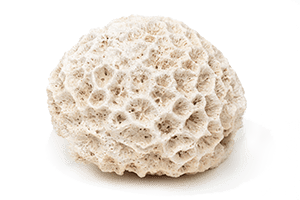Sodium is an essential major mineral. An adult body contains about 100 grams of sodium; about one-third of that sodium is found in bone. Most of the remaining sodium resides in extracellular fluids. Sodium is the major component of the cations (positively charged ions) of extracellular fluids. Sodium is present in stony corals at the level of about 129 ppm; the eleventh most abundant element found in stony corals. (Halstead)
Common table salt and chemical concoctions contain inorganic sodium not compatible with the human body; while organic sodium keeps calcium in solution in the human body. (Jensen) Sodium and potassium are two closely interacting minerals. All cell membranes of the body have a powerful sodium-potassium pump that continually pumps sodium to the outside of the cell (extracellular fluid) and potassium to the inside of the cell. This sodium-potassium pump performs a continual surveillance role in maintaining normal cell volume. (Guyton)
Too much inorganic sodium increases the requirement for potassium and throws off the sodium-potassium balance. Prolonged sodium-potassium imbalance is associated with hypertension (high blood pressure), increased incidence of kidney stones, osteoporosis and congestive heart failure (CHF). (Bergner) Although sodium deficiency is very rare in Western cultures, it may occur. When it does occur, as result of excessive perspiration, burns, vomiting and diarrhea or purposeful omission, the symptoms of sodium deficiency are muscle weakness, dizziness, headaches, decreased blood pressure, increased heart rate and shock. (Bergner, Jensen)
Biochemistry of the Sodium-Potassium Pump, Bob Owen, unpublished manuscript.
The Chemistry of Man, Bernard Jensen, pages 334-335,
Fossil Coral Stony Minerals, Bruce W. Halstead, pages 60-61.
The Golden Seven Plus One, C. William West,
The Healing Power of Minerals, Paul Bergner, pages 127-129.
Textbook of Medical Physiology, Arthur Guyton and John Hall, page 52.
